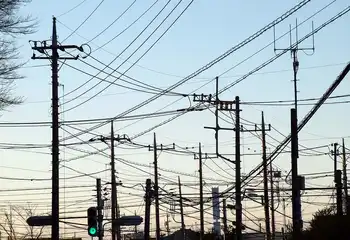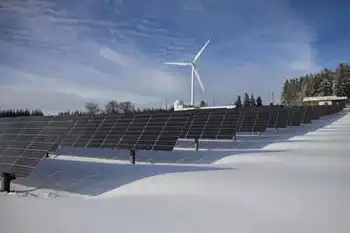Coal powers energy hungry Utah
By Deseret News
NFPA 70e Training - Arc Flash
Our customized live online or in‑person group training can be delivered to your staff at your location.

- Live Online
- 6 hours Instructor-led
- Group Training Available
In today's world, harnessing electricity is as easy as plugging into a wall outlet in a home or apartment — and you don't have the danger of being hurt by a lightning bolt.
But where does that power come from?
According to students in Kim Rees' fifth-grade class at the Waterford School in Sandy, the sources vary.
"It comes from the Lake Powell generators," student Sean Frommelt said. "The water turns the big generators."
"Turbines go around really, really fast, which creates electricity," 11-year old Zach Abrams explained.
Natilyn Gunnell noted that electricity comes from the sun using solar panels. Hunter Sullivan said the wind is also a source of energy generation.
Not bad for a class of 10- and 11-year-olds.
Now, how much do adults know about where their power comes from? As it turns out, at least as much as the fifth graders.
When asked about the various sources of electricity in Utah, a group of mountain hosts at Snowbird Resort offered similar answers, albeit with a bit more detail.
"Coal and some nuclear, but mostly coal," said Lisa Milkavich of Salt Lake City.
"Hydro-power and coal-generated electricity," added Kris Hill of Draper. Other voices shouted, "wind power," "solar power" and "geothermal."
The only sources not mentioned by either group were natural gas, petroleum-fired energy and biomass.
But while both children and adults seem to have a good idea where Utah's power comes from today, the state's future sources of electricity could be significantly different.
A recent study titled "Building the Clean Energy Economy: A Study on Jobs and Economic Development of Clean Energy in Utah" analyzed the impacts of a statewide energy portfolio that includes 20 percent of electricity sales from renewable resources by 2020.
Utah boasts some of the most diverse and relatively abundant natural resources in the nation, which has resulted in some of the lowest utility rates in the country.
Approximately 82 percent of the electricity produced in Utah in 2008 was from coal-fired generation, with six plants active statewide, according to the Utah Geological Survey. Natural gas accounted for the second-largest proportion at 15.6 percent. Hydroelectric provided 1.4 percent, while geothermal and petroleum each comprise less than 1 percent of net generation of electricity in Utah.
Other sources, such as solar and wind energy, make up an even smaller proportion of the total energy mix. As for the state's top electricity source, coal is mined deep underground and transferred via conveyor or truck to what insiders refer to as "an energy conversion factory."
"We take the chemical energy in the coal and turn that into heat energy," Kent Mower, operations superintendent of the PacifiCorp-owned Huntington power plant in Emery County, told the Deseret News. "That heat is released into a boiler and changes the water into steam. The steam drives the turbine, and the generator is coupled to the turbineÂ… and it's converted from mechanical energy into electrical energy."
Mower said the electricity is transmitted by power lines across the state, and some excess power is exported to locations all over the country.
"We connected to the Western Energy Grid, which could transmit electricity to Utah, Wyoming, Idaho, Oregon or Washington," Darrell Cunningham, Huntington plant managing director, told the Deseret News.
Michael Vanden Berg, energy data specialist for the Utah Geological Survey, wrote in the publication "Utah's Energy Landscape" that about 75 percent of the electricity generated at Intermountain Power Project near Delta is consumed in California.
"The source of the electricity at the customer's electric outlet can be estimated based on PacifiCorp's Utah's largest electricity provider resource energy mix data," he said. "For example, in 2009, a PacifiCorp customer can estimate that 4.5 percent of the electricity they consumed was generated by renewable resources such as wind, solar, geothermal or biomass and that 8.9 percent comes from hydroelectric sources according to company data."
PacifiCorp also reported that, in 2009, coal accounted for 58 percent of electricity consumed in Utah. By 2018, the company estimates that coal will account for just more than 40 percent of electricity consumed, with renewables climbing to nearly 10 percent of the energy mix and natural gas consumption increasing to almost 20 percent.
While residential energy use varies widely because of home size and electrical appliances used, the "typical" home uses an average of 700 to 800 kilowatt hours each month, Rocky Mountain Power spokesman David Eskelsen told the Deseret News in an e-mail. That translates into about 9,000 kilowatt-hours, or nine megawatt-hours, annually.
Those expected changes could have a significant effect on Utah's economy. A study released June 30 by the Eccles School of Business at the University of Utah showed the profound impact of Utah's coal industry on the economy, particularly in the rural counties of Carbon, Emery and Sevier.
The report, "The Structure and Economic Impact of Utah's Coal Industry," was authored by senior research economist Pamela Perlich, along with research analysts Michael Hogue and John Downen of the Bureau of Economic and Business Research at the Eccles School of Business.
"Utah's coal industry has played a significant role in the economic development of the state for well over a century and continues to be an influential player," Perlich said.
According to the study, the coal mining industry accounted for approximately 4,700 jobs — 1,900 directly and another 2,800 through indirect "ripple effects." Of those jobs, 85 percent were in Carbon, Emery and Sevier counties. The industry's direct financial impact to the state was $196 million for the year.
Coal also powers another industry that accounts for even more jobs and revenues than does coal mining — electricity generation.
Since the 1980s, coal-based electrical generation has accounted for more than 80 percent of the net electricity generated in Utah compared with approximately half of net generation for the country as a whole.
Nationally, 2008 data from the U.S. Energy Information Administration indicated that coal accounted for nearly 49 percent of electricity generation, with natural gas responsible for just over 21 percent, while nuclear power was the third-largest source at about 20 percent. The data showed hydroelectric, renewables and petroleum accounted for the remaining approximately 10 percent.
Mower said, looking forward, energy producers will have to work harder at developing cleaner, cost-effective sources of power to meet the ever-growing demand for electricity.
"Our engineers look closely at efficiency and ways to get more out of the existing power plant units and, of course, control emissions," he said.











